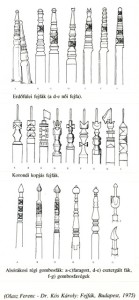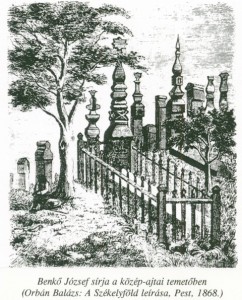HUNGARIAN WOODEN GRAVE-POSTS
In some Transylvanian Székely villages, there are still cemetery sections, where wooden grave-posts can be found, reminding us of the traditional Hungarian burial gardens. These are not cemeteries, but cheerful flower gardens, decorated with beautifully carved poles. They are the mirror image of the living community, preserving the traditional and democratic order of the Székely-Hungarian villages.
These carved grave-markers generally have no inscription. Nevertheless, the carvings denote every important information about the deceased, such as blood relation, age, sex, material and social status, occupation and cause of death and can be “read” by any interested member of the same community.
There are three types of carved grave-posts based on development and symbolism. During past centuries these types fused, their meaning changed or vanished.

a) Fejfa: Posts, put at the head of the grave. They portrayed the dead and were probably called ‘idols’ before Christianity. They belong to the oldest stratum of Hungarian folkart as they developed at a time when homage to the ancestors in tribal societies was important.
b) Kopjafa: These markers were essential to soldiers’ graves. It is not accidental that this old tradition of the Eurasian horsemen-cultures is preserved by the Hungarian-Székely soldier society.
c) Gombosfa: Posts put at the foot of the grave. They were decoratively carved poles to carry the coffin to the grave and used as temporary grave-markers. They are similar to type a), but their proportions are not the same. In some Transylvanian villages they are called ‘carry out poles’. These carved posts probably developed after the Hungarians settled in the Carpathian Basin, being the most recent type of the three.
Using carved posts as grave-markers in Transylvanian villages is unique to Hungarians in Europe. This tradition is still alive. Visit the old cemeteries, learn about this ancient tradition, and pass it on to the next generations.
(Translated by Emese Kerkay)
Sorce: Olasz Ferenc – Dr. Kós Károly, Fejfák, Budapest, 1975
American Hungarian Museum, No. 24., 1993

